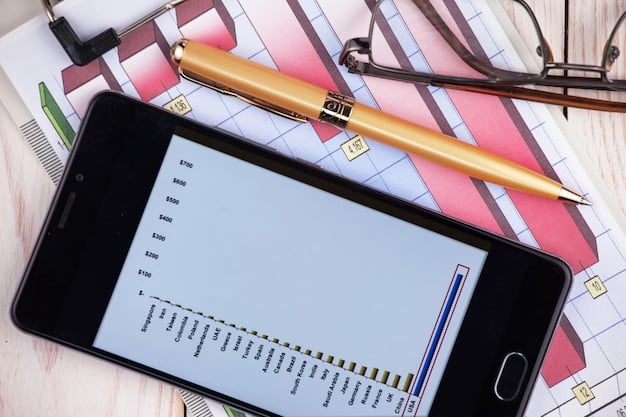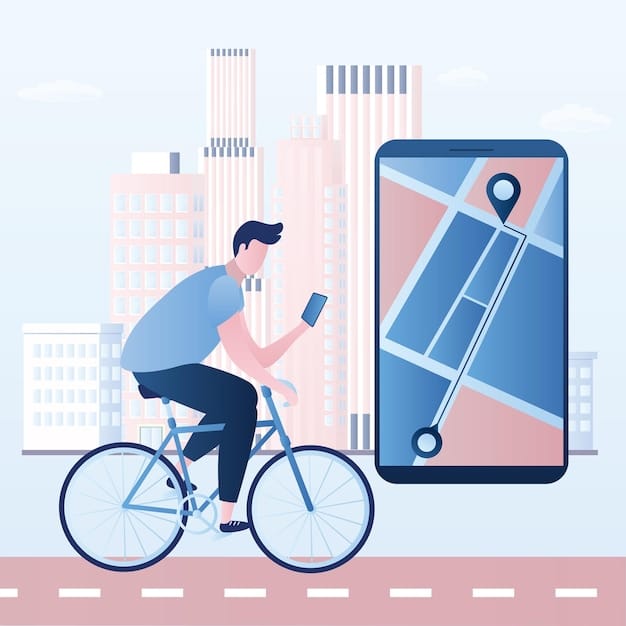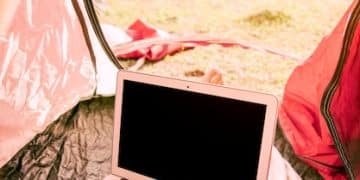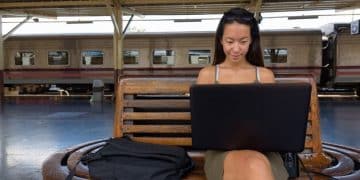Digital Nomad Budgeting: US Living on $3,000/Month

Digital nomad budgeting in the US requires strategic planning to live comfortably on $3,000 a month by optimizing accommodation, transportation, food, and activities to align with a location-independent lifestyle.
Embarking on a digital nomad journey in the US can seem daunting due to the perceived high cost of living. However, with careful digital nomad budgeting: How to live comfortably on $3,000 a month while exploring the US is entirely achievable, blending financial savvy with the freedom to explore diverse landscapes and cultures.
Crafting Your Digital Nomad Budget in the US
Creating a realistic and effective budget is the cornerstone of successful digital nomadism. Understanding your income sources, identifying essential expenses, and setting financial goals will pave the way for a sustainable and enjoyable experience. This section helps you formulate a budget that supports your lifestyle while allowing for financial flexibility.
Assess Your Income and Savings
Begin by taking stock of your income streams. Are you relying solely on freelance work, or do you have passive income sources? Accurately determine your monthly income and available savings before setting out on your adventure. This will help you understand how much you can comfortably spend each month.
Identify Essential Expenses
List all your mandatory expenses, such as accommodation, transportation, food, internet, health insurance, and business-related costs. Research average prices in different regions of the US to estimate these expenses accurately. Be realistic about your spending habits and adjust the budget accordingly.

Set Financial Goals
Define your short-term and long-term financial goals. Are you saving for a major purchase, paying off debt, or investing for retirement? Integrate savings goals into your budget to ensure you’re making progress toward your financial objectives while living the digital nomad lifestyle.
- Track your expenses regularly to stay within your budget.
- Allocate a buffer for unexpected costs to avoid financial stress.
- Review your budget monthly and adjust as needed to adapt to changing circumstances.
By carefully assessing your income, identifying essential expenses, and setting financial goals, you can create a solid budget that allows you to live comfortably and explore the US as a digital nomad. Prioritize financial planning to ensure your nomadic lifestyle remains sustainable and enjoyable.
Finding Affordable Accommodation
Housing is often the most significant expense for digital nomads. Exploring various accommodation options, such as shared housing, extended-stay hotels, and strategic location choices, can help you reduce your monthly costs significantly. This section provides practical tips for securing budget-friendly lodging while maintaining comfort and convenience.
Explore Shared Housing Options
Consider renting a room in a shared house or apartment through platforms like Airbnb, Craigslist, or Facebook Marketplace. Shared housing can offer a more affordable alternative to renting an entire apartment, and it also provides opportunities to connect with like-minded individuals.
Consider Extended-Stay Hotels
Extended-stay hotels often offer discounted rates for longer stays. Look for hotels with kitchenettes or free breakfast to save on food expenses. These hotels provide a balance of comfort and affordability, especially in urban areas.
Choose Locations Wisely
Opt for locations with a lower cost of living. Cities in the Midwest or South often have more affordable housing options compared to major metropolitan areas. Research the average rental costs in different regions to make informed decisions before settling down in a location.
- Negotiate for lower rates, especially during the off-season.
- Look for accommodations with included utilities to avoid extra monthly expenses.
- Read reviews and ratings to ensure the accommodation meets your standards.
Finding affordable accommodation is crucial for maintaining a healthy budget. By exploring shared housing options, considering extended-stay hotels, and choosing locations wisely, you can significantly reduce your housing expenses and enjoy a more comfortable digital nomad experience.
Smart Transportation Strategies
Transportation costs can quickly add up, especially when exploring a vast country like the US. Implementing smart transportation strategies, such as utilizing public transit, opting for long-term car rentals, and choosing walkable or bike-friendly cities, can help you minimize these expenses. This section highlights cost-effective transportation options for digital nomads.
Maximize Public Transportation
In cities with robust public transportation systems, take advantage of buses, trains, and subways to get around. Purchase monthly passes or multi-day tickets for better value. Public transportation is often more affordable and eco-friendly than driving a car.
Evaluate Long-Term Car Rentals
If you plan to travel extensively, consider a long-term car rental. Many rental companies offer discounted rates for rentals lasting a month or longer. Factor in gas, insurance, and maintenance costs to determine if this option is more economical than using ride-sharing services or relying on public transit.

Select Walkable and Bike-Friendly Cities
Choose cities that are easy to navigate on foot or by bicycle. Many cities have invested in bike lanes and pedestrian-friendly infrastructure. Walking and biking are not only cost-effective but also offer a great way to explore your surroundings and stay active.
- Use ride-sharing services sparingly and only when necessary.
- Consider carpooling to split costs with other travelers.
- Research local transportation options and discounts before arriving in a new location.
With smart transportation strategies such as public transport, long-term car rentals and walkable cities digital nomads can effectively manage their expenses. Prioritizing these strategies will enable you to explore more of the country while staying within your budget.
Eating Well on a Budget
Food expenses can quickly spiral out of control if you’re not careful. Planning your meals, cooking at home, and taking advantage of free food options can help you maintain a healthy diet without breaking the bank. This section offers practical tips for eating well while sticking to your $3,000/month budget.
Plan Your Meals
Create a weekly meal plan to avoid impulse purchases and reduce food waste. Plan your meals around sales and seasonal produce. This helps you make healthier choices while saving money.
Cook at Home
Cooking your own meals is significantly cheaper than eating out. Experiment with simple, budget-friendly recipes. Invest in a few essential kitchen tools to make cooking easier and more enjoyable.
Utilize Free Food Options
Take advantage of opportunities to get free food, such as community events, potlucks, and free food pantries. Many communities offer free meals or food assistance programs. Check local listings for events and resources in your area.
- Shop at discount grocery stores to save on staples.
- Pack your own lunches and snacks to avoid eating out during the day.
- Cook in bulk and freeze leftovers for future meals.
By planning your meals, cooking at home, and utilizing free food options, you can enjoy a nutritious and satisfying diet while staying within your budget. Prioritizing smart food choices will contribute significantly to your financial stability as a digital nomad.
Leveraging Free Activities and Entertainment
Entertainment doesn’t have to be expensive. Exploring free activities, such as hiking, visiting parks, and attending community events, can provide enriching experiences without straining your budget. This section highlights creative ways to have fun and stay engaged without spending a lot of money.
Explore the Great Outdoors
Take advantage of the US’s stunning natural landscapes by hiking, camping, and visiting national and state parks. Many parks offer free admission days or low-cost annual passes. Enjoy the beauty of nature and get some exercise without spending a fortune.
Attend Community Events
Check local listings for free community events, such as concerts, festivals, and art exhibits. These events provide opportunities to experience local culture and connect with others without spending money on expensive entertainment.
Visit Museums on Free Days
Many museums offer free admission days or evenings. Plan your visits around these free days to explore art, history, and culture without paying admission fees. This is a great way to enrich your mind and expand your horizons.
- Join local social media groups to find out about free events and activities.
- Take advantage of free walking tours to learn about the history and culture of your location.
- Organize potlucks and game nights with fellow travelers to enjoy social time without overspending.
By exploring free activities, attending community events, and visiting museums on free days, you can enrich your digital nomad experience without straining your budget. Embrace these cost-effective ways to have fun and stay connected while living on $3,000 a month.
Maximizing Digital Resources and Connectivity
Reliable internet access is essential for digital nomads. Optimizing your digital resources, leveraging free Wi-Fi, and using affordable data plans can help you stay connected without incurring high costs. This section offers strategies for maximizing digital connectivity on a budget.
Utilize Free Wi-Fi Hotspots
Take advantage of free Wi-Fi hotspots at libraries, coffee shops, and public spaces. Use a VPN to protect your data when using public Wi-Fi. While free Wi-Fi can be convenient, be mindful of security risks and take precautions to safeguard your information.
Invest in a Reliable Data Plan
Research affordable data plans from mobile carriers that offer nationwide coverage. Consider a mobile hotspot or portable Wi-Fi device for reliable internet access in areas where free Wi-Fi is not available. Compare different plans to find the best value for your needs.
Optimize Digital Tools
Use free or low-cost digital tools for communication, project management, and collaboration. Many free apps and software programs offer similar functionality to paid versions. Explore open-source software and free online resources to reduce your expenses.
- Download content for offline use to minimize data consumption.
- Utilize cloud storage services to access files from anywhere without relying on local storage.
- Explore VoIP services such as Skype or Google Voice for affordable international calls.
By maximizing free Wi-Fi, investing in a reliable data plan, and optimizing your digital tools, you can stay connected without overspending. Prioritizing cost-effective digital solutions will ensure you can maintain your work and social connections while sticking to your budget.
Planning for Healthcare and Insurance
Healthcare and insurance are essential considerations for digital nomads. Researching affordable health insurance options, understanding emergency medical services, and taking preventative health measures can help you protect your wellbeing without incurring unexpected costs. This section provides guidance on navigating healthcare and insurance while living on a budget.
Research Affordable Health Insurance
Explore different health insurance options that cater to digital nomads, such as travel insurance, international health insurance, or domestic health insurance with nationwide coverage. Compare plans based on coverage, deductibles, and premiums to find the most suitable option for your needs.
Understand Emergency Medical Services
Familiarize yourself with the local emergency medical services in each location you visit. Save emergency contact numbers in your phone and know the location of the nearest hospitals and clinics. Understanding how to access healthcare in case of an emergency can provide peace of mind and ensure timely assistance.
Practice Preventative Health
Take preventative health measures to minimize the risk of illness and injury. Maintain a healthy diet, exercise regularly, and get adequate sleep. Consider investing in a first-aid kit and over-the-counter medications to manage minor health issues without needing to visit a doctor.
- Consider a health savings account (HSA) to save money for healthcare expenses.
- Research telehealth services for remote consultations with doctors and specialists.
- Keep a copy of your medical records and insurance information easily accessible.
By researching affordable health insurance, understanding emergency medical services, and practicing preventative health, you can protect your wellbeing without straining your budget. Prioritizing your health is crucial for maintaining a sustainable and enjoyable digital nomad lifestyle.
| Key Point | Brief Description |
|---|---|
| 🏠 Affordable Housing | Prioritize shared housing and strategic locations. |
| 🚌 Smart Transport | Use public transit, walk, or bike when feasible. |
| 🍳 Budget Eating | Plan meals and cook home often. |
| 🌐 Digital Resources | Maximize free WiFi and affordable data plans. |
FAQ
▼
Cities like Tulsa, Oklahoma City, and Memphis offer low living costs and vibrant cultures, making them ideal for digital nomads managing their budget. They provide opportunities for work and leisure without significant financial strain.
▼
Aim to save at least three to six months of living expenses. This cushion helps cover unexpected expenses and provides financial security as you adjust to the fluctuating income that freelancing may bring.
▼
Consider travel insurance with medical coverage, or international health insurance. This will protect you from costs associated with medical emergencies, travel disruptions, and other unforeseen events while you are on the move.
▼
Identify cafes with good Wi-Fi or invest in a portable Wi-Fi device. Additionally, explore options for unlimited data plans with a reliable mobile carrier to manage connectivity and workflow interruptions effectively.
▼
Keep accurate records of your income and expenses to determine your tax obligations. Consult with a tax professional who specializes in digital nomad taxes to ensure compliance with state and federal laws, while minimizing any liabilities.
Conclusion
Living comfortably on a $3,000-a-month budget while exploring the US as a digital nomad is achievable with careful planning and smart financial decisions. By prioritizing affordable housing, transportation, mindful eating, and leveraging free activities, you can enjoy a fulfilling and sustainable nomadic lifestyle.





